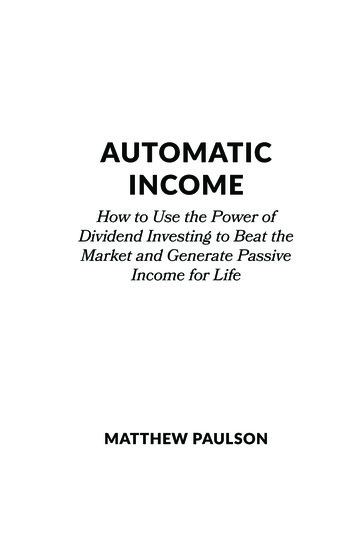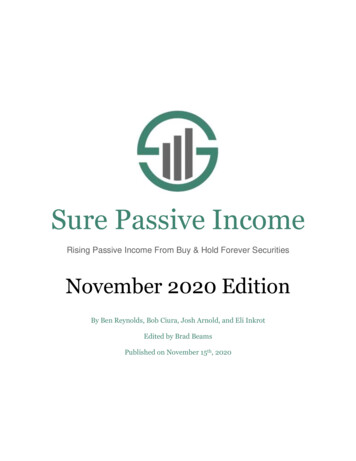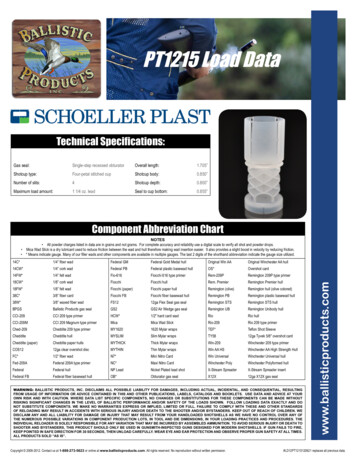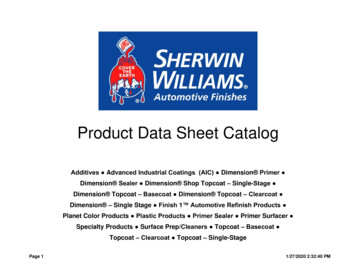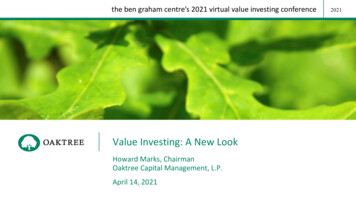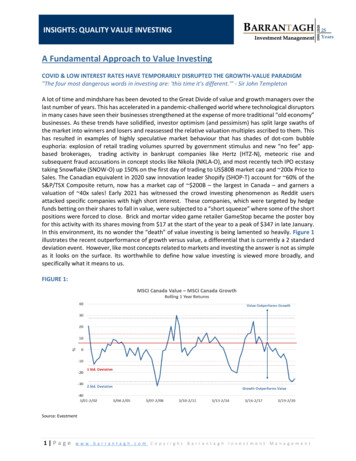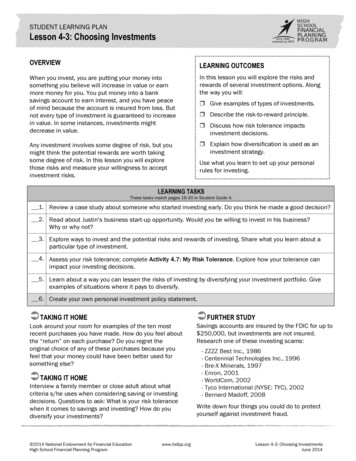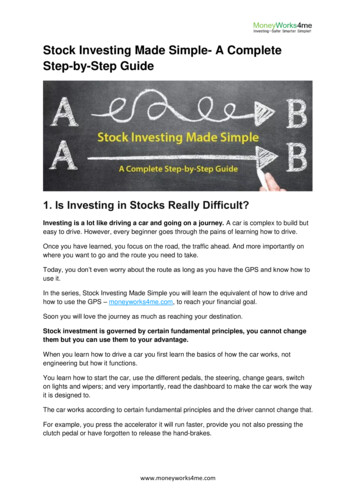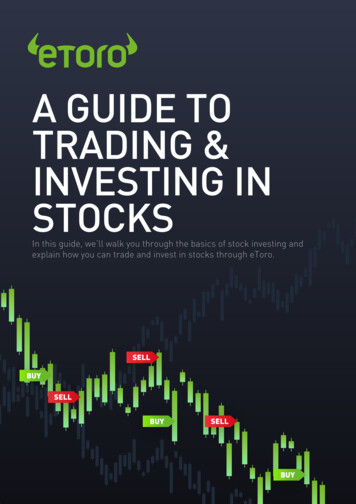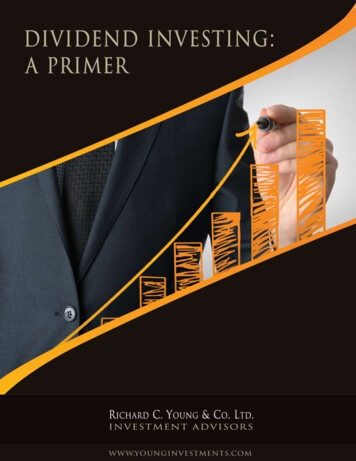
Transcription
DIVIDEND INVESTING:A PRIMERRICHARD C. YOUNG & CO., LTD.I N V E S T M E N TA D V I S O R Sw w w. y o u n g i n v e s t m e n t s . c o mwww.younginvestments.com
Dividend Investing: A Primer“One of the most persuasive tests of high quality is an uninterrupted record of dividendpayments going back over many years. A record of continuous dividend payments for the last 20years or more is an important plus factor in a company’s quality rating.”“For the vast majority of common stocks, the dividend record and prospects have always beena most important factor in controlling investment quality and value. In the majority of cases, thecommon has been influenced more markedly by the dividend than by reported earnings. In otherwords, distributed earnings have had a greater weight in determining market price than haveretained earnings.”-Benjamin Graham, The Father of Value InvestingA painful lesson learned by many investors since the turn of the century is to not relysolely on capital appreciation for stock-market gains. Investors who pursued speculativegains during the dot-com bubble and in the years leading up to the real-estate collapsewere left with not only decimated portfolios, but with portfolios that produced littleannual income.The ultralow-yielding NASDAQ index has more than doubled over the last five years,but the reality for NASDAQ investors is that for the first 15 years this century, theindex badly underperformed bonds and put investors through two bruising bear markets. That’s a decade and a half with very little return. And if you think you can avoida similar fate because you buy the “safer” non-dividend-payers, consider this, during a16-year period from 1965 to 1981, the blue-chip Dow Jones Industrial Average fell 10%in price. Sixteen years is most of a retirement for many investors. The performanceof the NASDAQ and the Dow in these two periods is a sobering reminder that stockprices can remain depressed for agonizingly long periods.Give Dividends a Starring RoleA possible solution to these long dry spells is to give dividends a starring role in yourportfolio. Dividends have historically been a vital component of long-term stock-market returns. Over short time frames and during long bull markets, dividends may seemCopyright 2022 Richard C. Young & Co., Ltd.2
Dividend Investing: A Primertrivial—but as Figure 1 illustrates, over the last eight decades, dividends have accountedfor an average of 50% of each decade’s stock-market returns. In the first 15 years ofthe 21st century, when the NASDAQ barely gained any ground, high-dividend-payers(highest yielding quintile) compounded investors’ money at 7%. And during that 16year period from 1965 to 1981, when the Dow fell in price, high-dividend-yieldingstocks earned a compounded annual return of 8.1%.Figure 1: S&P 500 Share of Return From DividendsDividends and thereinvestment ofdividends have historically accountedfor over half of stockmarket returns.Average 50%Negative returnof NASDAQ in2000s makes %of return fromdividends notmeaningful.When you measure over multi-decade periods, the impact of dividends on investmentreturns becomes clearer. Over the last 40 years, dividends and the reinvestment ofdividends have accounted for over 60% of the S&P 500’s total return.A Steady Stream of IncomeDividend stocks, and especially high-dividend-yielding stocks, have appeal for all typesof investors. A continuous stream of dividends can be used for living expenses (idealfor retirees) or reinvested at a lower share price, resulting in higher future-dividend payments (ideal for long-term wealth accumulation). A steady stream of cash also makesit easier for investors to avoid the emotionally charged decisions that tend to sabotageportfolios in down markets.Copyright 2022 Richard C. Young & Co., Ltd.3
Dividend Investing: A PrimerFigure 2 compares the capital-gains component of returns to the dividend componentof returns for high-yielding stocks. Note the stability of dividend returns compared tocapital gains.Figure 2: Dividend Return vs. Capital AppreciationCapital AppreciationDividend ReturnPercentThe stability ofdividend returnscan offer comfort toretired investors.Reduce Risk with Dividend StocksWhat’s more, dividends help reduce portfolio volatility. Figure 3 (next page) showsthat high-yielding stocks have been less volatile than non-dividend-paying stocks. Andhigh-yielders have held up better in down markets than both non-dividend-payers andbroad-based stock-market indices such as the S&P 500.Dividends: A Shortcut to QualityA dividend strategy may also help you avoid many of the pitfalls that wreak havoc oneven the most seasoned investors’ portfolios. Dividend-paying companies are oftenmore durable businesses than non-dividend-payers. Payers are also more likely to operate in industries with higher barriers to entry and have stronger balance sheets thannon-dividend-payers. And because there is a stigma associated with cutting dividendCopyright 2022 Richard C. Young & Co., Ltd.4
Dividend Investing: A PrimerFigure 3: High Dividend Payers Less RiskyNon-Dividend PayersS&P 500High Dividend PayersHistorically, highdividend payerslose less in downmarkets.Standard DeviationAverage Return in Down Marketpayments, the consistent payment of dividends is a signal of management confidence inthe future prospects of a company. This is especially true of companies that raiseDividend payers areoften durable businesses with strongbalance sheets.dividends. Management teams rarely commit to higher dividend payments unless theyare confident the dividends can be maintained.Cold, hard cash in the form of quarterly dividend payments may also be a sign of strongcorporate management. Who can forget the accounting frauds of Enron, WorldCom,and Tyco and their impact on many retirement portfolios? Not a single company in thegroup paid a meaningful dividend. Companies can manipulate and fake earnings by using creative accounting techniques, but regular dividend payments can’t be faked.A Free Lunch?What is the trade-off for consistent income, lower risk, and higher quality? Wouldyou believe the possibility of higher long-term returns? Although one might expect ahigh-quality, low-risk strategy to generate lower long-run returns, the opposite has beentrue. Over the long run, high-yielding stocks have outperformed the broader market.Copyright 2022 Richard C. Young & Co., Ltd.5
Dividend Investing: A PrimerNot every year, of course, but over time, the highest-yielding quintile (top 20%) ofstocks beat the market by a substantial margin (Figure 4).Figure 4: Large-Cap. Stocks vs. High Dividend Paying StocksHigh dividend payersturn 1,000 into 4.9million vs. 2 millionfor large-cap stocks-a difference of 2.6million.Large-cap StocksLog ScaleHigh Yield StocksFaster Earnings Growth from Dividend-PayersIf you have avoided dividend-payers in the past because you’ve assumed they are boring businesses with low growth prospects, you may be surprised by the historical facts.Historically, companies that returned more earnings to shareholders in the form of dividend payments had greater earnings growth. Why? Is it not true that the fastest-growing companies often pay no dividends at all? Indeed it is, but high dividend paymentslimit the amount of cash management teams have at their disposal. The resulting scarcity of capital forces CEOs to pursue only those projects offering the most promise. Atnon-dividend-paying companies, where retained earnings are abundant, managementteams are often more likely to make questionable acquisitions or invest in marginal expansion projects that hurt profitability.Copyright 2022 Richard C. Young & Co., Ltd.6
Dividend Investing: A PrimerDividend-Payers As an Inflation HedgeWith global central banks once again stimulating the financial system while continuingto hold interest rates at historic lows, the risk of accelerating inflation is ever-present.Stocks shouldn’t be the first asset class you think of for inflation protection, but theydo have an important inflation-fighting role to play in your portfolio.Stocks tend to maintain their purchasing power during inflationary periods becausethey are real assets. When inflation rises, the revenues, earnings, and dividends of companies tend to rise as well. Figure 5 shows that dividends per share for the S&P 500 haveoutpaced inflation by a wide margin.Figure 5: S&P 500 Dividends per Share vs. CPIIndex (January 1950 100)Dividend payershelp fight inflation.S&P 500 Dividends Per ShareConsumer Price IndexSource: Young Research & Publishing, Inc. & MacrobondDon’t Speculate: InvestIf you’ve harbored doubts about a dividend strategy, we hope we have establishedthat for investment purposes (as opposed to speculation) a dividend strategy can bea winning approach for you. Dividend stocks provide a steady stream of income forcompounding, they are often higher-quality businesses than non-dividend-payers, theyhistorically have been less volatile in down markets, and for investors who have a timehorizon longer than a year or two, dividend-payers offer the prospect of market-beatingreturns.Copyright 2022 Richard C. Young & Co., Ltd.7
Dividend Investing: A PrimerGetting Started with Dividend StocksOnce you have made the decision to pursue a dividend strategy, how do you choosethe best dividend stocks? Should you buy the highest-yielding stocks, or should youfavor those with the highest dividend growth? Should you stick to large-capitalizationdividend stocks or pursue small-capitalization dividend stocks as well? Should you limitpurchases to U.S. stocks or invest abroad?Since dividend-payers beat non-dividend-payers, one might assume that the higher thedividend yield, the better. But that isn’t always true. Yield alone is not the best indicatorof future stock performance. A high dividend yield can be a warning sign that the dividend may be unsustainable, or that the dividend-paying company is not growing. Thehistorical record shows that an investment strategy that buys the highest-yielding 10%of the stock market and rebalances annually delivers investment returns that trail stockswith high, but not the highest, yields.Figure 6 shows the compound annual return over the last 47 years of five portfoliosformed based on dividend yield. As you can see, the portfolio including stocks from thehighest-yielding group actually earned less than did the other four.Figure 6: Highest Yielders Not BestBuying high, but notthe highest yieldershas historically beena better investmentstrategy than buyingthe highest yielders.Source: Kenneth French data library. The chart shows the performance of the top five decile portfolios that were formed by dividend yield.Copyright 2022 Richard C. Young & Co., Ltd.8
Dividend Investing: A PrimerDividend Growth is KeyAt Richard C. Young & Co., Ltd., an important feature of our investment strategy isCompanies thatmake regulardividend increases,have historicallybeaten companiesthat don’t by asmuch as 39.8%.crafting dividend portfolios that include companies with high dividend yields, a historyof regular dividend payments, and a record of consistent dividend increases. Studiesby market research firm Ned Davis show that companies that have increased theirdividends regularly have outperformed dividend-payers lacking dividend growth by asmuch as 39.8%. The combination of a high dividend yield today and higher dividendpayments tomorrow can be a potent tonic for investment portfolios.A Focus on Dividend IncreasesTo build a portfolio of what we believe are the best dividend paying stocks, we focusour domestic stock investing on companies that have increased their annual dividendpayment for at least 10 consecutive years.We also invest in international dividend payers for our clients. Foreign companiesdon’t always adhere to the same dividend conventions as U.S. companies, so restrictingour investment universe to only companies that have increased their dividend for 10consecutive years isn’t practical. Instead we look for foreign firms that have a dividendpolicy calling for regular dividend hikes even if they don’t occur every year.For the dividend investor, foreign markets can offer compelling opportunities. Thereare many foreign markets where stocks consistently yield more than those in the U.S.Some even set minimum dividend-payout ratios for companies. Figure 7 shows that ofthe 44 countries in the MSCI All-Country World Index, the U.S. ranks 38 th in dividendyields. Savvy investors recognize that a global dividend portfolio can yield a muchgreater level of income than a domestic portfolio.As you can see in the chart on the next page, a well-crafted global dividend portfoliocan significantly increase an investor’s dividend income when compared to an investment in a broad U.S. stock market index.Copyright 2022 Richard C. Young & Co., Ltd.9
Dividend Investing: A PrimerFigure 7: MSCI Country Dividend YieldsPercentSavvy investors canboost income byinvesting abroad.Average YieldTake The Burden of Portfolio Management Off Your ShouldersThe strategies and insights we have shared with you in this report form the foundationof the equity investment strategy at Richard C. Young & Co., Ltd. We hope you havefound this report informative. Our goal is to help you and your family achieve long-terminvestment success with comfort and confidence. If you like the sound of what a globaldividend portfolio has to offer, Richard C. Young & Co., Ltd. can help. We manageglobal dividend portfolios for individuals, families, and businesses throughout the United States. Our portfolio minimum is 500,000.To schedule an appointment with one of our investment specialists, pleaseclick here or give us a call at 800-843-7273. Thank you for reading.Copyright 2022 Richard C. Young & Co., Ltd.10
DisclaimerPast performance is not indicative of future results. You should not rely on any past performance as a guarantee of future investment performance. e information on this report is forinformation purposes only. It is believed to be reliable, but Richard C. Young & Co., Ltd. does not warrant its completeness, timeliness or accuracy. is information is not intended as anoffer or solicitation for the purchase of any security or any nancial instrument. Further, the report is in no way intended to be a solicitation for private money management services offeredby Richard C. Young & Co. Ltd., Inc. e information and materials contained in this report and the terms and conditions or the access to and use of such information and materials aresubject to change without notice.Copyright notice e works or authorship contained in this report, including but not limited to all design, text, and images, are owned, except as otherwise expressly stated, by Richard C. Young & Co., Ltd.Except as otherwise expressly stated herein, they may not be copied, transmitted, displayed, performed, distributed (for compensation or otherwise), licensed, altered, framed, stored forsubsequent use, or otherwise used in whole or in part in any manner without Richard C. Young & Co., Ltd.’s prior written consent.RICHARD C. YOUNG & CO., LTD.I N V E S T M E N TA D V I S O R Sw w w. y o u n g i n v e s t m e nt s . c o m
Figure 4: Large-Cap. Stocks vs. High Dividend Paying Stocks High dividend payers turn 1,000 into 3.6 million vs. 2 million for large-cap stocks--a difference of 1.6 million. Log Scale High Yield
